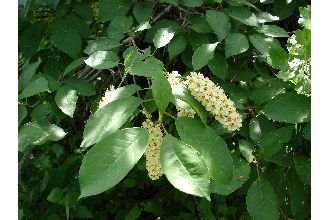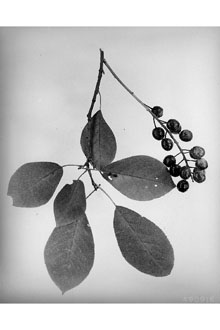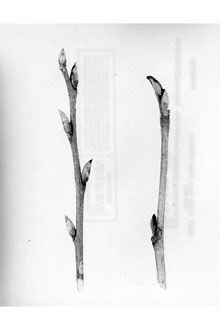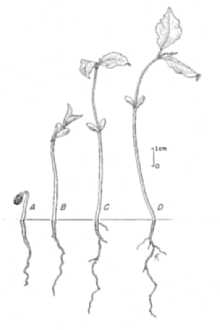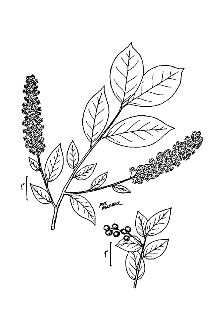Chokecherry
Scientific Name: Prunus virginiana L.
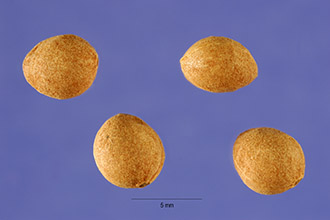
| General Information | |
|---|---|
| Usda Symbol | PRVI |
| Group | Dicot |
| Life Cycle | Perennial |
| Growth Habits | ShrubTree, |
| Native Locations | PRVI |
Plant Guide
Environmental Concerns
Concerns
Concerns
section of this document
Alternate Names
common chokecherry, choke cherry, black chokecherry, red chokecherry, California chokecherry, Virginia chokecherry, eastern chokecherry, western chokecherry, rum chokecherry, whiskey chokecherry, wild cherry, wild blackcherry, bird cherry, jamcherry, chokeberry, cabinet cherry, chuckleyplum, sloe tree, bitter-berry, caupulin, Use soil moisture sensors to measure the soil moisture of Chokecherry.,
Uses
Many people do not realize cherry and some other very important commercial fruit trees (apple, peach, plum, apricot, nectarines, and almonds) are in the rose family. Anthropologists indicate cherries have been harvested in Eurasia from 4,000 to 5,000 B.C. In 1629, chokecherry was imported to England where it has been cultivated as an ornamental. It was first cultivated in North America as an orchard crop in 1724. The seeds are toxic due to production of hydrocyanic acid in the leaves, stems and seeds. The almond nuts are treated to deactivate the poisonous glycosides before they are put on the market. Cases of illness and deaths have been traced back to eating the seeds of these trees. Conservation: Chokecherry is used extensively in shelterbelts, windbreaks, wildlife habitat and mass plantings for erosion control. Chokecherry does well in riparian area planting. It provides thermal cover over the water and works well in stabilizing streambanks. It has been used on disturbed sites such as mined land reclamation, highway right-of-ways and construction sites. It is a good erosion control plant because it can form thickets and spread by rhizomes. ©J.S Peterson @ PLANTS Wildlife: Chokecherry is important to many wildlife animals. Birds, rabbits, hares, rodents and bears all seek out and eat its fruit. It provides food, cover and nesting habitat for a variety of birds. Birds will also take advantage of its growth form for cover and nesting habitat. It is used extensively by deer as a browse source in the winter. The early spring flowers provide an important source of nectar for butterflies, honeybees and ants. Food: The common name, chokecherry, came from the bitter and astringent taste of the fruit. The fruit was a staple for numerous Indian tribes across the North American continent, especially to tribes who lived on the plains and prairies. Chokecherries were routinely cooked before they were eaten or dried thoroughly. Both methods served to break down any formation of prussic acid contained in the stone pits. Drying chokecherries improves their taste by sweetening them, or at the very least, getting rid of the naturally occurring bitter taste. Chokecherries were consumed in three ways by Indians. The fruit and/or juice were eaten. Whole cherries, including pulp, skin and stone, were pulverized into a pulp, shaped into balls and dried in the sun. Fruit balls could be stored for future use. Either boiling or drying the fruit will neutralize the naturally occurring hydrocyanic acid. The most important use was as part of the recipe for pemmican, or mince-meat. Pemmican was made by getting a slice of dried meat (bison was preferred over elk, deer or antelope) and pounding it with a stone until it had a fine texture. Bone marrow and animal lard were then heated and mixed with the meat. Crushed chokecherries were then added. Pemmican would be cached as a winter food. Some form of pemmican was a mainstay for all plains tribes. Chokecherry butter was made by cooking the mature fruit, straining out the seed and skins, mixing this poultice with an equal quantity of wild plums or crabapples and adding sugar. The bark was brewed for a tea drink. Many tribes would add the fruits to soups and stews as flavoring and as a thickening agent. A green branch was speared through a meat slab while it was cooking to add spice to the taste. Likewise, pioneers and settlers came to realize its food value. Mature fruits are still collected today and used to make jellies, jams, pie-fillings, syrups, sauces and wines. Like many plants and animals which were vital to their survival some tribes used parts of the chokecherry plant in their rituals. A green dye was derived from the leaves, inner bark and immature fruit. A purplish-red dye was derived from the ripe fruit. The Cheyenne used the limbs to make arrow shafts and bows. The Crows used it for tipi stakes and pins. Mountain men washed their steel traps in water boiled with the bark to remove the scent. It is speculated many tribes planted seeds in places they frequented to ensure a supply of chokecherries was always available. Chokecherry is being promoted for planting as a minor crop in the prairie provinces of Canada for juice production. Estimated fruit production potential is 15,000 pounds per acre from mature plants. There is a significant research effort in Canada for developing fruit producing cultivars. Landscaping: In some parts of the U.S., chokecherry is a popular ornamental. Its quick growth, mature size, attractive white flowers in the spring and strong, sweet and almond-like aroma fragrance make it a good yard tree in urban neighborhoods. Cultivars are planted for ornamentals rather than the native species. All native chokecherry varieties have a great tendency to sucker, which can create problems in lawn care. Most cultivated varieties do not have this suckering trait while producing more attractive flowers and/or larger fruit. The fruit also attracts a diverse population of birds for a number of weeks. Chokecherries can be a component in a screen or noise barrier planting. Ethnobotany: Chokecherry covered a large geographic range in North America, so a majority of tribes used it to treat a variety of health problems. It was valued especially for its astringent properties and beneficial effect upon the respiratory system. The Arika women would drink the berry juice to stop post-partum hemorrhage. The Blackfeet drank berry juice for diarrhea and sore throats. An infusion of the cambium layer mixed with Saskatoon serviceberry (Amelanchier almifolia) was taken as a general purge treatment and to lactating mothers so they could pass on the medicinal qualities to the nursing baby. They also used it in an enema solution for their children. Willow (Salix spp.) tea was used to counteract the laxative effect of chokecherry. The Cherokees used chokecherry in the following ways: mixed chokecherry with hazel alder (Alnus serrulata), downy rattlesnake plantain (Goodyera pubescens), Canadian wildginger (Asarum canadense) and yellowroot (Xanthorhiza simplicissima) to make a blood tonic. An infusion made from boiled bark was given for coughs, laryngitis, chills, ague, fevers and to loosen phlegm. Warm chokecherry tea was given to women when labor pains began. The root bark is a good astringent and was mixed with water and used as a rinse for open sores and old skin ulcers. The tree bark of spicebush (Lindera benzoin) and flowering dogwood (Cornus florida) was added to corn whiskey and used to treat for measles. The fruit was boiled and eaten to treat for bloody bowels. The branches and leaves were one of six ingredients burned in sweat lodges to treat for indigestion and jaundice. The Cheyenne would gather the immature fruit, dry it in the sun, pulverize it and use it as a treatment for diarrhea. The Paiutes made a medicinal tea from the leaves and twigs to treat colds and rheumatism. The Sioux chewed the dried roots and then placed this poultice in open wounds to stop the bleeding. The Sioux, Crows, Gros Ventres and others made a bark tea to cure stomach aches, diarrhea and dysentery. The Crows also used the bark to cleanse sores and burns. In the 19th century medical doctors used many concoctions of chokecherry leaves and bark to treat a number of ailments. Chokecherry bark was listed in the U.S. Pharmacopoeia from 1820 to 1970. It is still listed as a pharmaceutical aid, a flavor agent for liquid medicines. Among the health complaints treated were debility, hectic fever, irritative dyspepsia, irritability of the nervous system, fever, pleurisy, whooping cough, tuberculosis, pneumonia, sore throats and gastrointestinal problems. It was recommended as a rinse on burns, open sores, cankers and skin ulcers. Pharmaceutical books at that time cautioned against boiling any mixture using chokecherry leaves or bark because it would drive off the medicinal properties. The bark was used as a flavoring agent in many cough syrups. In 1834, Dr. Proctor first identified the bark as containing prussic acid. In their journals, Lewis and Clark recorded that while camped on the upper Missouri River Captain Lewis became will with abdominal cramps and fever. He made a tea from chokecherry twigs and was well the next day. Modern medicinal research shows in small dosages hydrocyanic acid can stimulate respiration, improve digestion and gives a false sense of well-being. Some cancer research involving hydrocyanic acid is being conducted. Margaret Williams, Nevada Native Plant Society, @ PLANTS
Status
Please consult the PLANTS Web site and your State Department of Natural Resources for this plant’s current status (e.g. threatened or endangered species, state noxious status, and wetland indicator values).
Weediness
This plant may become weedy or invasive in some regions or habitats and may displace more desirable vegetation if not properly managed. Please consult with your local NRCS Field Office, Cooperative Extension Service office, or state natural resource or agriculture department regarding its status and use. Weed information is also available from the PLANTS Web site.
Description
General: Rose Family (Rosaceae). Chokecherry is a native, perennial, deciduous, woody, thicket-forming large erect shrub or small tree. It rarely reaches a height of over 30 feet. The crown is irregular and from 10 to 20 feet wide when mature. The stems are numerous and slender. Reproduction can either be by seed or root rhizomes. Leaves are dark green and glossy above and paler beneath. They are alternate, simple, glabrous, oval to broadly elliptic in shape, 1 to 4 inches long, and 3/4 to 2 inches wide. The margins are toothed with closely-spaced sharp teeth pointing outward forming a serrated edge. They turn yellow in autumn. The bark of young trees may vary from gray to a reddish brown. As it ages the bark turns darker, into brownish-black and becomes noticeably furrowed. The bark is distinctly marked by horizontal rows of raised air pores (lenticels). With maturation the lenticels develop into shallow grooves. It has perfect flowers which are aromatic and arranged in cylindrical racemes 3 to 6 inches long. The racemes always grow on the current year's leafy twig growth. Individual flowers are perfect, 1/4 to 3/8 inch in diameter with 5 white petals. The flowers start appearing before the leaves are fully developed. Flowers may appear from April to July and fruits form a couple of months later. The fruits are spherical drupes (fleshy fruit with a stone in the center), globose, 1/4 to 3/8 inch in diameter. Small ripe cherries range in color from dark red or purple to almost black. There are from 3,000 to 5,000 seeds per pound. The roots are a network of rhizomes. Deep root systems grow at irregular intervals along the length of the rhizomes. Rhizomes can extend beyond the drip zone, up to 35 feet away from the base of the tree. Rhizomes grow up to 3/4 inch in diameter. There are three recognized varieties of Prunus virginiana. The variety demissa is commonly called western chokecherry. It produces dark red fruit. The variety melanocarpa produces black fruit. The variety virginiana produces crimson to deep red fruit. This variety can be found in two forms, one with red and one with white fruit. Habitat: Chokecherry is found in a large geographic area and it grows abundantly in many habitat types and plant associations. It may be found in thin stands, as dense thickets or individually in open
Known Distribution
Distribution
Distribution
Distribution: Chokecherry is found in all but eight states or territories. For current distribution, please consult the Plant Profile page for this species on the PLANTS Web site.
Establishment
Nursery grown seedlings establish satisfactorily if planted free of competition in areas having 15 or more inches of annual precipitation. If seeds are planted in the spring they should be pre-chilled for 3 months, then placed about 1/2 inch deep. Saplings are not tolerant of weedy competition for 2 to 3 years after planting. Use of weed barrier mat, a strict cultivation regime, or proper herbicide treatment is necessary if a successful planting is to occur. Check with your local NRCS Field Office to determine if chokecherry is adapted to your area or soils before planting any trees.
Management
Management of chokecherry will be dependent on whether it is looked upon as a desirable or undesirable plant. On range and pastures it is often considered a potential hazard to livestock. As a consequence either mechanical and/or herbicide treatments combined with good grassland management is needed to prevent animal loss. When it is used in windbreaks, as an ornamental plant or as a wildlife resource it is beneficial. Control of weedy vegetation, and treatment for potential diseases, is necessary if it is expected to grow for an extended period of years
Pests and Potential Problems
Chokecherry is susceptible to X-disease, black knot, stem decay, shothole, Valsa canker, and honey fungus Plowrightia stansburiana. Common insects pests are the prairie tent caterpillar, eastern tent caterpillar and aphids. In the northeastern United States, chokecherry is a primary host of the eastern tent caterpillar. Browsing by deer on young immature trees causes considerable damage in some areas. Environmental Concerns The leaves, bark, stem, and stone (seed pit) of chokecherry are all toxic. It is potentially poisonous to all classes of livestock, but cattle and sheep are the ones commonly affected. The meaty flesh of the fruit is not toxic. Hydrocyanic acid (HCN) is often called Prussic acid. HCN does not occur freely as a plant compound. It is formed only after disruption of the plant cell, either by mechanical injury or a sudden freeze. Only then do the degradative enzymes (hydroxynitrile lyases) and glycoside come into contact and mix together. HCN acid occurs in greatest amounts in the leaves. Generally, the amount of HCN in the leaves lessens as the growing season progresses. By autumn chokecherry leaves have so little glycoside, a component of HCN, they are not normally considered hazardous. Drought stress may cause the leaves to concentrate the glycoside in heavier amounts than usual. Wilted leaves are more toxic per unit weight due to dehydration, which concentrates the components, which make up HCN. HCN is so toxic at low levels because it inhibits blood cells from absorbing oxygen. One symptom of HCN poisoning is the blood turns bright red when exposed to the air and it clots abnormally slow. Cyanogenic glycosides (prunasin, produced in the leaves and twigs, and amygdalin, produced in the stone) are the building blocks for HCN. Of the two, prunasin is found in a much larger quantity. HCN is most commonly formed in the plant due to mechanical injury (such as browsing), a sudden change in temperature (an early and heavy frost) or in the animal during digestion. The glycosides can either be hydrolyzed by enzymes in the plants or by rumen microorganisms. The glycosides occur in vacuoles in plant tissue while the enzymes are found in the cytosol. Ingestion of about 0.25 percent of an animal's body weight, or 50 milligrams/kilogram of body weight, is the Lethal Dose of fifty percent of animals (LD50). This means less than 4 ounces of fresh leaves can be toxic to a 100 pound animal. Poisoning generally occurs when animals graze this amount or more in an hour or less. Formation of HCN must occur primarily within the short time between the mastication of the forage and its arrival in the stomach, for the acidic contents of the stomach slows down the reaction of the chemical process which creates the HCN. The toxic elements become even more active if the animal drinks water immediately after browsing. HCN works so quickly by the time poisoning symptoms are identified it is generally too late to treat. Injection of a combination of sodium thiosulfate and sodium nitrite in the veins or peritoneum is the recommended antidote. Oxidizing substances such as potassium permanganate or hydrogen peroxide given as a drench may help some. Any other medications promoting respiratory help and nerve stimulants may also contribute to recovery. For any treatment to be effective it must be given immediately upon symptoms of poisoning. Removing livestock from the HCN source is the only practical way to prevent mass poisoning and numerous losses once it has been detected. Good livestock management includes keeping hungry livestock away from areas where chokecherry is abundant. Maintaining a good level of preferred forage in pastures will do a great deal in preventing HCN poisoning. When a person eats a single apple seed or cherry pit, though not recommended, it is unlikely to cause discomfort or serious illness. However, there have been reported deaths, usually of children chewing on the stems and leaves, or swallowing the stones. Visible reactions to poisoning may include; anxiety; uneasiness; confusion; dizziness; vertigo; headache; nausea; vomiting; the lips turn blue; bloating; dilation of the eyes; muscular weakness; abnormal breathing, either very labored or very rapid; paralysis of the throat; irregular heart beat; convulsions; coma ensues and finally death. Clinically, death results from the general anoxic state created by the inhibition of cytochrome oxidase.
Seeds and Plant Production
Plant Production
Plant Production
Chokecherry can be propagated by seed, rhizome cuttings, suckers, crown division, semi-hardwood cuttings and grafting. Generally, seed crops are regular and viable. The flowers are more abundant and more fruit is produced on plants growing on open sites or in forest clearings. Natural dispersal of the seed occurs when it passes through the digestive tracts of mammals and birds. The seeds may be carried a long distance from the parent plant in this manner. If the rhizomatous roots are damaged due to a mechanical injury suckers will be produced. This is often how thickets are formed. A fire initially causes major damage to a stand of chokecherry. However, regrowth is enhanced for several years following a burn. It sprouts vigorously from surviving root crowns and suckers arise from the rhizomes. Chokecherry has seed dormancy. About half of the seed which is not stratified germinates within a couple of months. Delayed germination may occur up to 4 months. An after-ripening period in the presence of oxygen and moisture is needed for a majority of seed to germinate. Good germination can only be expected after a cool, moist stratification regime lasting 90 to 160 days at 36 to 41 degrees Fahrenheit. Sow 25 seeds per foot of drill row. One- year-old bareroot stock should be planted on deep, well-drained soils in sunny locations. Cultivars, Improved, and Selected Materials (and area of origin) Planting materials can be obtained from most commercial hardwood nurseries and seed sources. Several cultivars have been released by government agencies and private nurseries for use in landscaping and/or fruit production. The two most commonly marketed cultivars are 'Schubert', and 'Canada Red'. A lot of literature states that these two cultivars are the same one with just different names. This is not the entire truth. 'Schubert' is one of the oldest cultivars. Its parent rootstock is Prunus virginiana melanocarpa selected from a native stand near Valley City, North Dakota. It was released by the Oscar Will Nursery which was located in Bismarck. 'Canada Red' was created by grafting 'Schubert' on Mayday rootstock to get rid of the suckering trait. Releases from Canada include, 'Garrington', 'Goertz' and 'Robert'.
Control
Please contact your local agricultural extension specialist or county weed specialist to learn what works best in your area and how to use it safely. Always read label and safety instructions for each control method. Trade names and control measures appear in this document only to provide specific information. USDA, NRCS does not guarantee or warranty the products and control methods named, and other products may be equally effective.
References
Acuna, U.M., et. al. 2002. Antioxidant Capacities of Ten Edible North American Plants. Phytother Research. Volume 16, Number 1, Pp 63-65. Division of Pharmacognosy, University of Uppsala, Uppsala, Sweden. Anonymous. c.1864. General Directions for Collecting and Drying Medicinal Substances of the Vegetable Kingdom. List and Description of Indigenous Plants, etc. their Medicinal Properties; Forms of Administration, and Doses. Prunus Virginianus. Confederate States of America. Surgeon General's Office. Boger, C.M. 1887. Extractum Pruni Virginianae Fluidum. American Journal of Pharmacy. Volume 59, Number 5. Casserly, D. 1980. An Apple A Day Keeps the Doctor Away (But the Seeds Can Kill You!). The American Legion. Volume 108, Number 3. Pp. 16-17. CBIF. Canadian Poisonous Plants Information System. 2003. URL: (http://www.cbif.gc.ca/) (accessed 16 September 2003). Canadian Biodiversity Information Facility. Canada. Center for New Crops and Plants Products. 2003. Stone Fruits or Drupes. URL: (http://hort.purdue.edu/newcrop/Default.html) (accessed 31 July 2003). Purdue University. Center for New Crops and Plants Products. West Lafayette, Indiana USA. Coon, E.E. 1977. Cyanogenesis, The Production of Hydrogen Cynide, By Plants. In: Keeler, R.F.; Van Kampen, K.R.; James, L.F. 1978. Effects of Poisonous Plants On Livestock. Academic Press. New York, New York USA. Pp. 301-310. Coon, N. 1963. An American Herbal. Using Plants For Healing. Rodale Press. Emmaus, Pennsylvania USA. Pp. 167. Crawford, H.S.; Kucera, C.L.; Ehrenreich, J.H. 1969. Ozark Range and Wildlife Plants. Agriculture Handbook Number 356. United States Department of Agriculture. Forest Service. Washington, District of Columbia USA. Pp. 204. Densmore, F. 1928. How Indians Use Wild Plants For Food, Medicine and Crafts. Dover Publications, Inc. New York, New York USA. Pp. 291. DOI, USGS, NPWRC. 2003. Midwestern Wetland Flora. URL: (http://www.npwrc.usgs.gov/resource/othrdata/plntguid/species.htm#contents) (accessed 31 July 2003). Department of Interior. United States Geologic Service. Northern Prairie Wildlife Research Center. Jamestown, North Dakota USA. Evers, R.A.; Link, R.P. 1972. Poisonous Plants of the Midwest and Their Effects On Livestock. Special Bulletin 24. College of Agriculture. University of Illinois at Urbana-Champaign. Champaign, Illinois USA. Pp. 77. Felter, H.W.; Lloyd, J.U. 1898. Prunus Virginiana (U.S.P.)-Wild Cherry. King's American Dispensatory. URL at: (http://www.ibiblio.org/herbmed/eclectic/kings) (accessed 31 July 2003). The Public's Library and Digital Archive. Chapel Hill, North Carolina USA. Fernald, M.L. 1950. Gray's Manual of Botany, Eigth (Centennial) Edition. American Book Company, New York, New York USA. Pp. 879. Folwer, M.; Craigmill, A.L.; Norman, B.B.; Michelsen, P. 1982. Livestock-Poisoning Plants of California. Leaflet 21268. Division of Agricultural Sciences. University of California. Davis, California USA. Pp. 7-8. Gleason, H.A. 1952. The New Britton and Brown Illustrated Flora of the Northeastern United States and Adjacent Canada. New York Botanical Garden. Lancaster Press, Inc. Lancaster, Pennsylvania USA. Pp. 329. Gough, R.E. 2002. Growing Minor Stone Fruit in Montana. Montana State University Extension Service. Montana State University-Bozeman. Bozeman, Montana USA. Hamel, P.B.; Chiltoskey, M.U. 1975. Cherokee Plants. Pp. 28-29.
Fact Sheet
Alternate Names
common chokecherry, choke cherry, black chokecherry, red chokecherry, California chokecherry, Virginia chokecherry, eastern chokecherry, western chokecherry, rum chokecherry, whiskey chokecherry, wild cherry, wild blackcherry, bird cherry, jamcherry, chokeberry, cabinet cherry, chuckleyplum, sloe tree, bitter-berry, caupulin
Uses
Chokecherry is primarily used today as a food product that makes fine preserves, juice, jelly, and syrup. It is a very important commercial fruit tree. Anthropologists indicate cherries have been harvested in Eurasia from 4,000 to 5,000 B.C. In 1629, chokecherry was imported to England where it has been cultivated as an ornamental. It was first cultivated in North America as an orchard crop in 1724. Conservation uses include plantings in shelterbelts, windbreaks, wildlife plantings, and mass plantings for erosion control. CAUTION: PARTS OF THIS PLANT CAN BE POISONOUS The seeds are toxic due to production of hydrocyanic acid in the leaves, stems and seeds. The almond-like nuts are treated to deactivate the poisonous glycosides before they are put on the market. Cases of illness and deaths have been traced back to eating the seeds of these trees. In some parts of the U.S., chokecherry is a popular ornamental.
Status
Please consult the PLANTS Web site and your State Department of Natural Resources for this plant’s current status (e,g, threatened or endangered species, state noxious status, and wetland indicator values), , Use soil moisture sensors to measure the soil moisture of Chokecherry.
Description and Adaptation
Adaptation
Adaptation
General: Rose Family (Rosaceae). Chokecherry is a native, perennial, deciduous, woody, thicket-forming large erect shrub or small tree. It rarely reaches a height of over 30 feet. The crown is irregular and from 10 to 20 feet wide when mature. The stems are numerous and slender. Reproduction can either be by seed or root rhizomes. Leaves are dark green and glossy above and paler beneath. They are alternate, simple, glabrous, oval to broadly elliptic in shape, 1 to 4 inches long, and 3/4 to 2 inches wide. The margins are toothed with closely-spaced sharp teeth pointing outward forming a serrated edge. They turn yellow in autumn. The bark of young trees may vary from gray to a reddish brown. As it ages the bark turns darker, into brownish-black and becomes noticeably furrowed. The bark is distinctly marked by horizontal rows of raised air pores (lenticels). With maturation the lenticels develop into shallow grooves. It has perfect flowers which are aromatic and arranged in cylindrical racemes 3 to 6 inches long. The racemes always grow on the current year's leafy twig growth. Individual flowers are perfect, 1/4 to 3/8 inch in diameter with 5 white petals. The flowers start appearing before the leaves are fully developed. Flowers may appear from April to July and fruits form a couple of months later. The fruits are spherical drupes (fleshy fruit with a stone in the center), globose, 1/4 to 3/8 inch in diameter. Small ripe cherries range in color from dark red or purple to almost black. There are from 3,000 to 5,000 seeds per pound. The roots are a network of rhizomes. Deep root systems grow at irregular intervals along the length of the rhizomes. Rhizomes can extend beyond the drip zone, up to 35 feet away from the base of the tree. Rhizomes grow up to 3/4 inch in diameter. There are three recognized varieties of Prunus virginiana. The variety demissa is commonly called western chokecherry. It produces dark red fruit. The variety melanocarpa produces black fruit. The variety virginiana produces crimson to deep red fruit. This variety can be found in two forms, one with red and one with white fruit. Chokecherry occurs naturally in a wide range of soil types and textures. Many wildlife animals eat the fruit and distribute it. Birds, rabbits, hares, rodents and bears all seek out and eat its fruit. Distribution: Please consult the Plant Profile page for this species on the PLANTS Web site.
Establishment
Nursery grown seedlings establish satisfactorily if planted free of competition in areas having 15 or more inches of annual precipitation. Use of weed barrier mat, a strict cultivation regime, or proper herbicide treatment is necessary if a successful planting is to occur. Check with your local NRCS Field Office to determine if chokecherry is adapted to your area or soils before planting any trees.
Management
On range and pastures it is often considered a potential hazard to livestock. As a consequence either mechanical and/or herbicide treatments combined with good grassland management is needed to prevent animal loss. Control of weedy vegetation, and treatment for potential diseases, is necessary if it is expected to grow for an extended period of years
Pests and Potential Problems
Chokecherry is susceptible to X-disease, black knot, stem decay, shothole, Valsa canker, and honey fungus Plowrightia stansburiana. Common insect pests are the prairie tent caterpillar, eastern tent caterpillar and aphids. In the northeastern United States, chokecherry is a primary host of the eastern tent caterpillar. Browsing by deer on young immature trees causes considerable damage in some areas.
Environmental Concerns
The leaves, bark, stem, and stone (seed pit) of chokecherry are all toxic. It is potentially poisonous to all classes of livestock, but cattle and sheep are the ones commonly affected. The meaty flesh of the fruit is not toxic. Poisoning generally occurs when animals consume 0.25 percent or more of their body weight in toxic plant material in an hour or less. Tim Dring, USDA NRCS Washington State Office Eating a single seed or cherry pit, though not recommended it is unlikely to cause discomfort or serious illness. However, there have been reported deaths, usually of children chewing on the stems and leaves, or swallowing the stones. Cultivars, Improved, and Selected Materials (and area of origin) Planting materials can be obtained from most commercial hardwood nurseries and seed sources. Several cultivars have been released by government agencies and private nurseries for use in landscaping and/or fruit production. The two most commonly marketed cultivars are 'Schubert', and 'Canada Red'. 'Schubert' is one of the oldest cultivars. Its parent rootstock is Prunus virginiana melanocarpa selected from a native stand near Valley City, North Dakota. Releases from Canada include, 'Garrington', 'Goertz' and 'Robert'.
Plant Traits
Growth Requirements
| Temperature, Minimum (°F) | -43 |
|---|---|
| Adapted to Coarse Textured Soils | Yes |
| Adapted to Fine Textured Soils | Yes |
| Adapted to Medium Textured Soils | Yes |
| Anaerobic Tolerance | Medium |
| CaCO3 Tolerance | High |
| Cold Stratification Required | Yes |
| Drought Tolerance | Medium |
| Fertility Requirement | Medium |
| Fire Tolerance | High |
| Frost Free Days, Minimum | 120 |
| Hedge Tolerance | Low |
| Moisture Use | Medium |
| pH, Maximum | 8.4 |
| pH, Minimum | 5.2 |
| Planting Density per Acre, Maxim | 2728 |
| Planting Density per Acre, Minim | 682 |
| Precipitation, Maximum | 65 |
| Precipitation, Minimum | 13 |
| Root Depth, Minimum (inches) | 20 |
| Salinity Tolerance | Medium |
| Shade Tolerance | Intolerant |
Morphology/Physiology
| Bloat | None |
|---|---|
| Toxicity | Severe |
| Resprout Ability | Yes |
| Shape and Orientation | Erect |
| Active Growth Period | Spring and Summer |
| C:N Ratio | High |
| Coppice Potential | No |
| Fall Conspicuous | Yes |
| Fire Resistant | No |
| Flower Color | White |
| Flower Conspicuous | Yes |
| Foliage Color | Green |
| Foliage Porosity Summer | Dense |
| Foliage Porosity Winter | Porous |
| Foliage Texture | Medium |
| Fruit/Seed Conspicuous | Yes |
| Nitrogen Fixation | None |
| Low Growing Grass | No |
| Lifespan | Short |
| Leaf Retention | No |
| Known Allelopath | Yes |
| Height, Mature (feet) | 25.0 |
| Height at 20 Years, Maximum (fee | 15 |
| Growth Rate | Rapid |
| Growth Form | Multiple Stem |
| Fruit/Seed Color | Black |
Reproduction
| Vegetative Spread Rate | Moderate |
|---|---|
| Small Grain | No |
| Seedling Vigor | Medium |
| Seed Spread Rate | Slow |
| Seed per Pound | 4971 |
| Fruit/Seed Persistence | Yes |
| Propagated by Tubers | No |
| Propagated by Sprigs | No |
| Propagated by Sod | No |
| Propagated by Seed | Yes |
| Propagated by Corm | No |
| Propagated by Cuttings | No |
| Bloom Period | Mid Spring |
| Commercial Availability | Routinely Available |
| Fruit/Seed Abundance | High |
| Fruit/Seed Period Begin | Summer |
| Fruit/Seed Period End | Summer |
| Propagated by Bare Root | Yes |
| Propagated by Bulb | No |
| Propagated by Container | Yes |
Suitability/Use
| Veneer Product | No |
|---|---|
| Pulpwood Product | No |
| Protein Potential | Medium |
| Post Product | No |
| Palatable Human | Yes |
| Palatable Graze Animal | Low |
| Palatable Browse Animal | High |
| Nursery Stock Product | No |
| Naval Store Product | No |
| Lumber Product | No |
| Fuelwood Product | High |
| Fodder Product | No |
| Christmas Tree Product | No |
| Berry/Nut/Seed Product | No |

